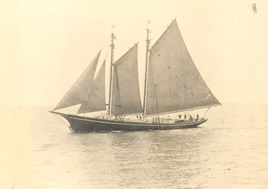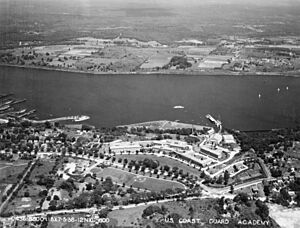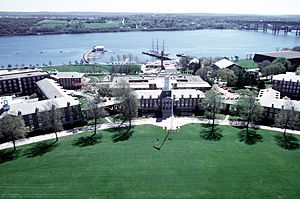United States Coast Guard Academy facts for kids
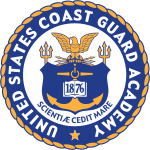 |
|
|
Former names
|
Revenue Cutter Service School of Instruction (1876–1914) Revenue Cutter Academy (1914–1915) |
|---|---|
| Motto | Scientiæ Cedit Mare (Latin) |
|
Motto in English
|
The sea yields to knowledge |
| Type | U.S. Service Academy |
| Established | 1876 |
| Superintendent | Gregory C. Rothrock |
| Provost | Amy K. Donahue |
| Commandant of Cadets | Aaron Casavant |
|
Academic staff
|
175 |
| Students | 1,113 cadets (As of fall 2023) |
| Location |
,
United States
41°22′22″N 72°06′06″W / 41.37278°N 72.10167°W |
| Campus | Suburban 103 acres (420,000 m2) |
| Fight song | "Semper Paratus" |
| Colors | Blue and orange |
| Nickname | Bears |
|
Sporting affiliations
|
|
| Mascot | Objee the Bear |
| Athletics | 24 varsity teams |
 |
|
The United States Coast Guard Academy (USCGA) is a special college in New London, Connecticut. It's the main school for people who want to become officers in the United States Coast Guard. The academy started in 1876. It helps students learn and train to become leaders in the Coast Guard.
Students at the academy are called cadets. They are training to be officers. When they finish school, they get a college degree called a Bachelor of Science. They also become an ensign in the U.S. Coast Guard. The education is free, but in return, graduates agree to work for the Coast Guard for at least five years. If they go to flight school or other special training, they serve even longer.
About 300 cadets start each summer, and around 250 graduate. Cadets pick from nine main subjects to study. Their progress is judged on their schoolwork, military behavior, physical fitness, character, and leadership skills. The academy's motto is Scientiæ Cedit Mare, which means "the sea yields to knowledge" in Latin.
Contents
History of the Academy
The Coast Guard Academy began as the "School of Instruction of the Revenue Cutter Service" in 1876. It was located near New Bedford, Massachusetts. The school used a ship called the USRC James C. Dobbin for training. Captain John Henriques was the first leader of the school.
Students learned subjects like math, science, and English. It was mostly a two-year training program with some classroom lessons. Only about five to ten cadets were in each class. Over time, the school moved to different places. In 1900, it moved to Curtis Bay, Baltimore. Then, in 1910, it moved to Fort Trumbull in New London, Connecticut.
In 1914, the school became the Revenue Cutter Academy. A year later, in 1915, it became the Coast Guard Academy. This happened when the Revenue Cutter Service joined with the United States Life-Saving Service to create the U.S. Coast Guard.
New land was bought in New London in 1930 to build the current academy campus. Construction started in 1931. The new buildings were ready, and cadets moved in by September 1932.
In 1946, the academy received a large sailing ship called the Horst Wessel. It was a war reparation from Germany. This 295-foot tall ship was renamed USCGC Eagle. The Eagle is still used today to train cadets and other Coast Guard officers.
The academy welcomed its first Black cadets in 1962. In 1976, women were also allowed to join the academy.
How to Get In
Unlike some other military academies, you don't need a special nomination from a member of Congress to get into the USCGA. This was decided by Captain John A. Henriques, the first leader of the school.
Each year, more than 2,000 students apply to the academy. About 400 students are offered a spot. The average class size that starts is around 300 cadets. New cadets arrive in late June or early July for "Swab Summer." This is a tough basic military training program. It helps them get ready for their first year at the academy.
After four years of studying and training, about 250 of those cadets will graduate. Around 40 percent of the cadets are women.
What Cadets Learn
All cadets who graduate become officers in the United States Coast Guard. They also earn a Bachelor of Science degree. The academy teaches science and professional skills. Cadets take classes for two semesters each year. They spend most of the summer doing military training. This helps them become good officers with the right skills.
They take courses in leadership, ethics, and how organizations work. They also learn about nautical science, which is about ships and the sea. Most graduates go to their first Coast Guard jobs right after graduation. These jobs can be on ships, at shore units, or in basic flight training. Cadets learn how to pilot ships, plan voyages, and handle all parts of ship operations. They also learn about Coast Guard leadership and duties.
Study Subjects
The USCGA focuses on science and engineering subjects. However, cadets can choose from different areas of study. Some majors also offer specializations. For example, marine and environmental science majors can focus on biology, chemistry, or geology. Cadets can also take some classes at Connecticut College, which is next to the academy.
Military Training Activities
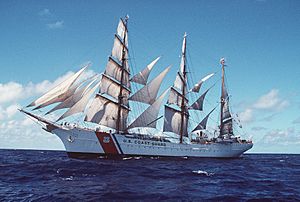
Every summer, cadets take part in different training programs based on their year.
- Swab Summer: New freshmen arrive and join the military. They go through seven weeks of basic training. This training ends with a week-long trip on the barque USCGC Eagle.
- Third-class (3/c) Summer: Cadets spend five weeks training on the USCGC Eagle. They also spend five weeks on a real Coast Guard cutter or at a small boat station. They act like junior enlisted crew members.
- Second-class (2/c) Summer: This summer includes training in damage control and weapon skills. They also learn navigation rules and can do aviation internships. They spend three weeks helping to train the new freshmen (swabs).
- First-class (1/c) Summer: Cadets spend ten weeks on an active cutter. They act like junior officers, helping to steer the ship. Some exceptional cadets can do an internship for five weeks and then spend five weeks on a cutter.
During the school year, cadets have a formal military drill called regimental review every week. They also have other military duties at the academy. Coast Guard cadets are active-duty military members. They wear uniforms all the time. They get a monthly payment to help pay for books, uniforms, and other things they need.
How Cadets are Organized
The cadets are organized into one large group called a regiment. This regiment is split into eight companies. Each company has about 120 cadets from all different years. The Commandant of Cadets, a high-ranking Coast Guard officer, oversees the cadets. However, the academy believes in "the Corps leading the Corps." This means the cadets largely lead themselves.
The cadets follow a military chain of command:
- First-class cadets (seniors) lead the entire group.
- Second-class cadets help train the new freshmen. They also guide and develop the fourth-class cadets. They act as mentors.
- Third-class cadets are role models for the fourth-class cadets.
- Fourth-class cadets are responsible for learning and using Coast Guard values. These include leadership, teamwork, and accountability.
The highest-ranking cadet in each company is the company commander. These are first-class cadets. Each company has some freedom in how it operates. However, all company commanders report to the regimental staff. This staff plans and oversees all parts of cadet life. The top cadet leader is the regimental commander. Getting a leadership role is very competitive. A cadet's overall class rank often helps decide who gets these positions.
The eight companies are named after the first eight letters of the NATO phonetic alphabet: Alfa, Bravo, Charlie, Delta, Echo, Foxtrot, Golf, and Hotel. Each company has a special job for daily tasks:
- Alfa Company handles health and wellness.
- Bravo Company manages training.
- Charlie Company takes care of the honor system.
- Delta Company organizes drills and ceremonies.
- Echo Company manages transportation and supplies.
- Foxtrot Company handles cadet conduct and updates rules.
- Golf Company provides supplies for cleaning and repairs.
- Hotel Company plans fun events for morale.
Each company is further divided into departments and then into divisions. Divisions are the smallest units. Each division has a specific purpose. A first-class cadet leads each division. It includes cadets from all other years. This structure helps every cadet learn leadership skills. It also copies the way a Coast Guard cutter is organized.
Student Life
| Race and ethnicity | Total | |
|---|---|---|
| White | 63% |
|
| Hispanic | 14% |
|
| Two or more races | 11% |
|
| Asian | 6% |
|
| Black | 3% |
|
| International student | 3% |
|
| Unknown | 1% |
|
Sports and Athletics
The USCGA has 24 intercollegiate sports teams for cadets. The academy's teams usually compete in Division III of the National Collegiate Athletic Association. Cadets spend two hours each school day on sports. They can join varsity teams, club teams, or other sports activities. The academy's nickname is the Bears. This name comes from the USRC Bear ship. This ship made a famous rescue in Alaska in 1897.
Music and Arts
Many non-athletic activities at the academy are focused on music. These activities take place in Leamy Hall. There are instrumental groups like the Regimental Band and the NiteCaps Jazz Band. There are also vocal groups such as the Chapel Choirs, Glee Club, and the Fairwinds a cappella group. The Idlers are an all-male group that sings sea shanty songs.
Model UN
The academy has a Model UN team that started in 2004. This team has done well in competitions across North America. They have also competed at the World Model UN Conference.
Campus Spirit
The academy has clubs and teams that help boost campus morale. These include the cheer squad, dance team, and the Social Committee.
Notable Graduates
Graduates of the Coast Guard Academy are known as the "Long Blue Line." Many have gone on to achieve great things.
- Worth G. Ross (Class of 1879) was a leader of the Coast Guard.
- Elmer Fowler Stone (Class of 1913) was a pilot who helped make the first naval transatlantic flight.
- Bruce E. Melnick (Class of 1972) was the first Coast Guard astronaut.
- Sandra L. Stosz (Class of 1982) was the first woman to lead a United States military service academy.
- Linda L. Fagan (Class of 1985) became the 27th Commandant of the United States Coast Guard in 2022. She is the first female service chief in the U.S. armed forces.
- Andre Douglas (Class of 2008) was chosen for the NASA Astronaut Group 23.
- Nikole P. Barnes (Class of 2017) was the academy's first Olympic athlete. She competed in sailing at the Tokyo Olympic Games.
Academy Leaders (Superintendents)
The United States Coast Guard Academy has had many leaders, called Superintendents, since it began.
- The first Superintendent was John A. Henriques, who served from 1877 to 1883.
- Harry G. Hamlet was Superintendent from 1928 to 1932. He also wrote the "Creed of the United States Coast Guardsman."
- Sandra L. Stosz was the first woman to be Superintendent, serving from 2011 to 2015.
- The current Superintendent is Gregory C. Rothrock.
U.S. Coast Guard Museum
The U.S. Coast Guard Museum is located in Waesche Hall at the academy. The museum shows the history of the U.S. Coast Guard. It has ship models, old cannons, uniforms, medals, and paintings. If you want to visit, you need to bring a government-issued photo ID to enter the campus.
More to Explore
- United States service academies
- United States Air Force Academy (USAFA)
- United States Coast Guard Academy (USCGA)
- United States Merchant Marine Academy (USMMA)
- United States Military Academy (USMA; Army)
- United States Naval Academy (USNA)
- USCGC Eagle (WIX-327), a training ship that was originally built in Germany.
See also
 In Spanish: Academia de la Guardia Costera de Estados Unidos para niños
In Spanish: Academia de la Guardia Costera de Estados Unidos para niños


